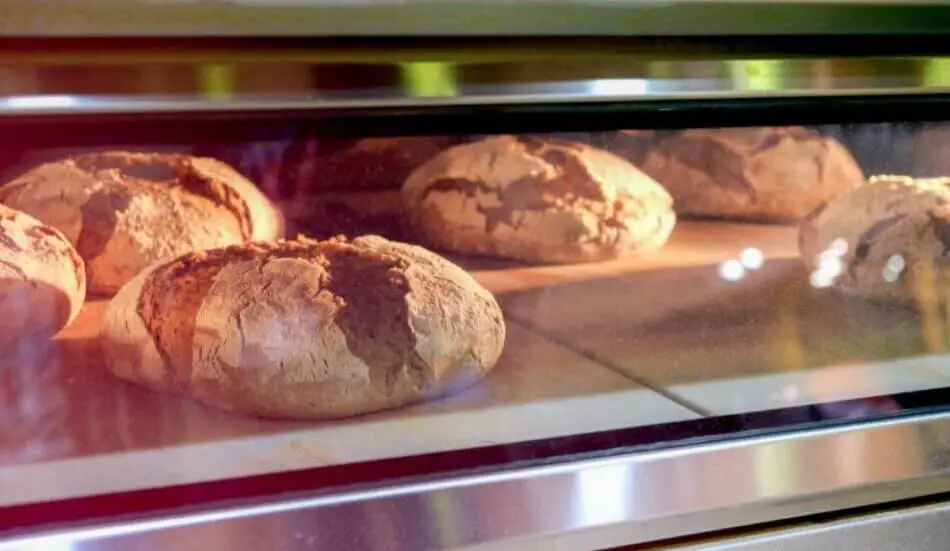The best technique for freezing sourdough bread to preserve its freshness is by allowing it to cool for 5 hours after it has left the oven, then wrap it tightly in plastic wrap such that an air-tight seal is created and immediately placing it in the freezer.
When reheating frozen sourdough bread, excessive moisture loss can be prevented by running the frozen loaf under tap water to lightly wet the outside of the loaf. The loaf is then baked in a preheated oven at 160 Celcius for 20-30 minutes or until its internal temperature reaches 90 Celcius.
Can I freeze my sourdough bread?
Freezing sourdough bread is a great way to preserve its freshness, taste and texture for up to 3 months; after 3 months the quality of the bread will start to diminish. If the frozen sourdough bread is reheated before 3 months, it will taste like one day’s old bread.
Sourdough bread goes stale over time due to starch retrogradation where water molecules dissipates out of the starch molecules, which causes the starches to change from a soft gelatinized state to a hard crystalline state. This is why as bread becomes more stale, it also becomes harder and stiffer.
Freezing (at -18 Celcius) slows down the staling process in sourdough bread as the frozen water molecules are trapped in the starches and is inhibited from any movement, thus perserving the freshness, taste and texture of the bread.
Refrigerating sourdough bread however, speeds up the staling process. Staling rate of sourdough bread is the highest between 0 – 10 Celcius which is in temperature range of our refrigerators.
Whatever you do, do not refrigerate your sourdough bread. Freeze it instead to preserve its freshness.
When should you freeze sourdough bread to maximize freshness?
The best time to freeze sourdough bread to maximize flavor and texture preservation is 5 hours after the sourdough bread has left the oven. Freezing the sourdough bread any earlier will result in a gummy crumb, while freezing any later will result in lost of freshness.
Sourdough bread should be cool for at least 4-5 hours after baking to allow water molecules in the starches to dissipate out, so that the starches can convert from a soft gelatinized state into a hard crystalline state.
If the sourdough bread is frozen immediately after the bread leaves the oven, the water molecules would have frozen solid before it can leave the starches, hence the starches remains in a soft gelatinized state, and when reheated and sliced, the crumb will be gummy and gooey in texture.
How to freeze sourdough bread for long term storage?

Freezing a whole sourdough loaf:
- Wait 4-5 hours for sourdough bread to cool to room temperature once it has left the oven.
- Wrap the sourdough loaf tightly with plastic wrap to create an airtight seal.
- Place the wrapped loaf in the freezer, and make sure nothing heavy is placed on top of it or it will get smashed.
Freezing sourdough bread slices:
- Wait 4-5 hours for sourdough bread to cool to room temperature once it has left the oven.
- Slice the sourdough bread.
- Place cut out parchment paper between the slices so they won’t stick.
- Wrap the sourdough slices tightly with plastic wrap to create an airtight seal.
- Place the wrapped slices in the freezer, and make sure nothing heavy is placed on top of it or it will get smashed.
It is important to wrap the loaf or slices tightly with plastic to create an airtight seal to prevent the sourdough bread from getting freezer burn. Freezer burn damages frozen food by dehydration and oxidation caused by air getting to food that is not securely wrapped in air-tight packaging.
Slicing your sourdough bread before freezing is a great way to store your sourdough bread if you have a small family. You can reheat the exact number of slices that you will be consuming, and you do not have to reheat the whole frozen loaf.
Once a frozen sourdough loaf or slice is reheated, it has to be consumed immediately, as it will turn stale much more rapidly when it has cooled down.
How do you reheat frozen sourdough bread?

Reheating a whole frozen loaf:
- Preheat the oven to 160 Celcius.
- Remove the frozen loaf from the freezer.
- Run it quickly through tap water, only to lightly wet the outside.
- Load it into the preheated oven.
- Bake for 20-30 minutes or until internal temperature reaches 90 Celcius.
Reheating a frozen slice:
- Preheat the oven toaster to 160 Celcius.
- Remove the frozen slice from the freezer.
- Mist it lightly with tap water.
- Load it into the preheated oven.
- Bake for 10-15 minutes or until the desired browning is achieved.
A sourdough bread that was baked twice, will inevitably lose more moisture than a loaf that was baked once, leading to a drier loaf. The loaf is mildly saturated on the outside with water to reduce moisture loss during the second bake.
Do not wait for the bread to thaw to room temperature before reheating, as the bread will further stale during the thawing time. The frozen bread can be reheated without burning in the oven as the oven temperature is relatively low at 160 Celcius.
The purpose of the reheating our sourdough bread is to increase its internal temperature to 90 Celcius, where most of the effects of staling would have been reversed.
Staling occurs due to a process known as starch retrogradation where water molecules leave the starch molecules as the bread is cooled, such that the starch molecules convert from a soft gelatinized state into a hard crystalline state.
When the sourdough bread is reheated to 90 Celcius, water molecules are reabsorbed by the starch molecules, and the starch molecules exists as a gelatinized state which is soft, reversing starch retrogradation and the staling process.
Can you eat expired bread if it was refrigerated?
Freezing sourdough bread delays the staling process, prolonging the bread’s expiration date; expired frozen sourdough bread can be eaten up to 3 months past the expiration date.
Refrigerating sourdough bread speeds up the staling process, reducing the bread’s expiration date; expired sourdough bread that was refrigerated has most likely gone stale, and should be reheated until its internal temperature reaches 90 Celcius before eaten (or until well toasted).
Does freezing sourdough bread kill probiotics?
Probiotics are made up of live yeast and bacteria that can be beneficial for your digestive system.
Although there are plenty of living wild yeast and bacteria in sourdough bread before it is baked, once it is baked, all the yeast and bacteria dies when temperature of the loaf reaches about 60 Celcius. Freezing the bread, does not kill any of the probiotics, as they are already dead from the high heat in the oven.
However if you are freezing your dough with the intention of baking it at a later date, the yeast and bacteria activity will slow down tremendously, and does not die off. When the dough is thawed to room temperature, fermentation activity will resume, and you can bake the sourdough like you would normally.

